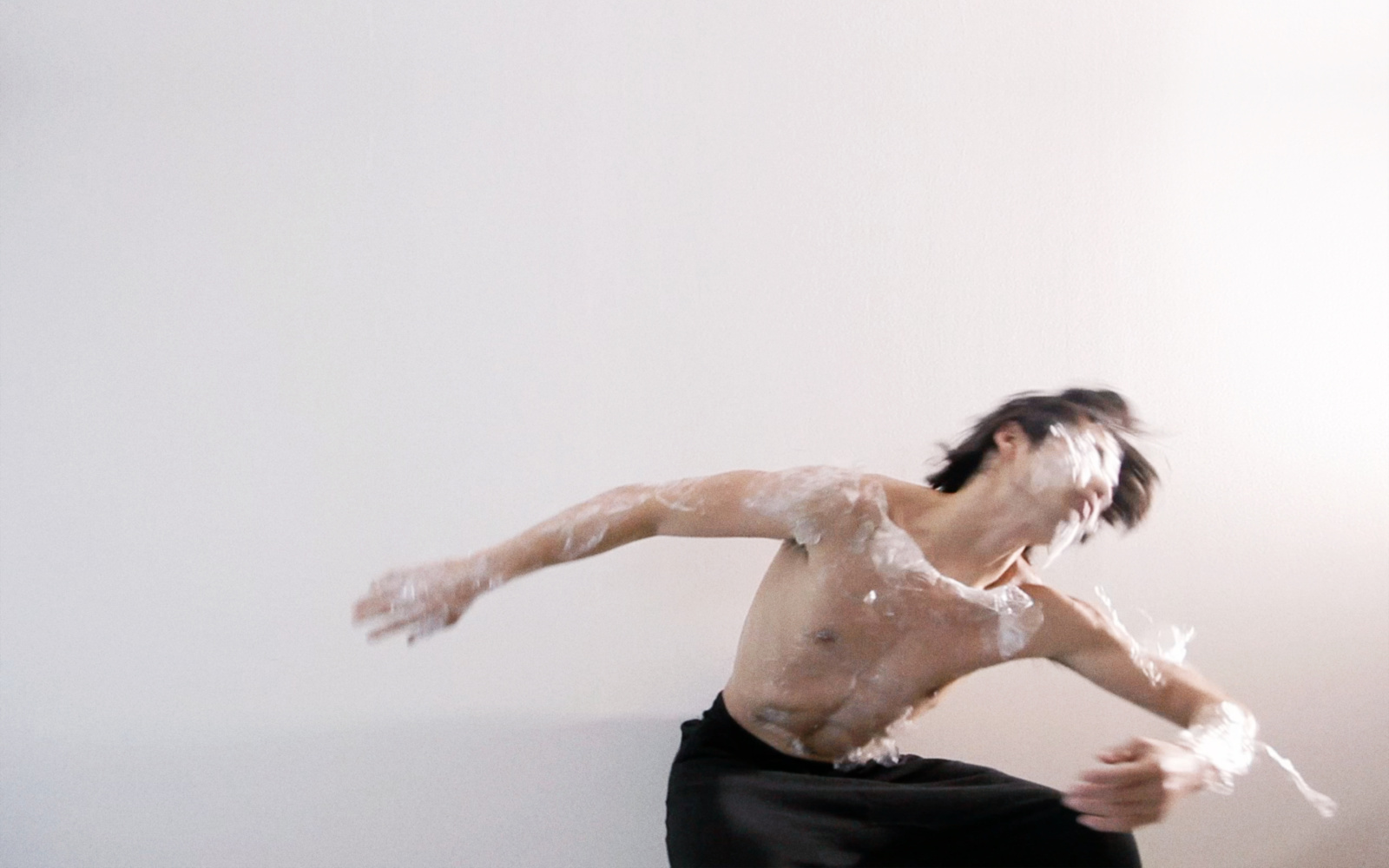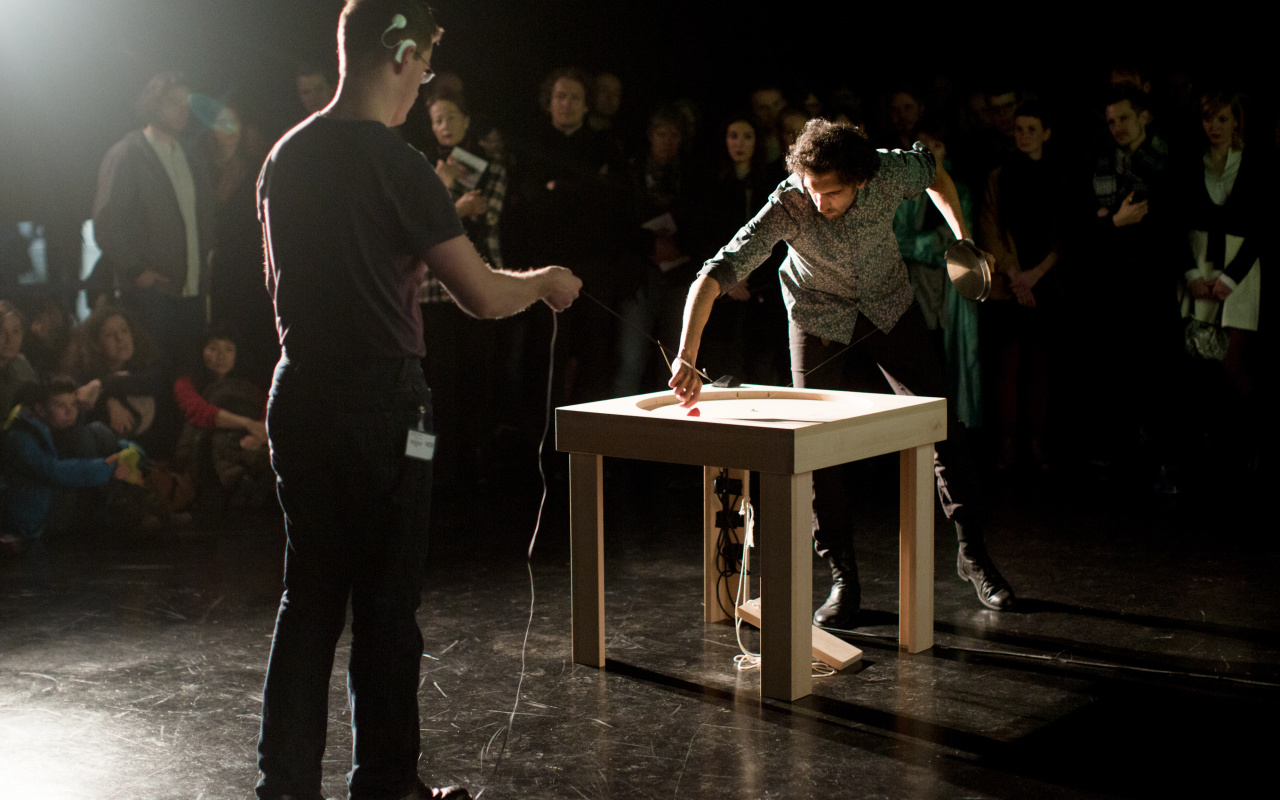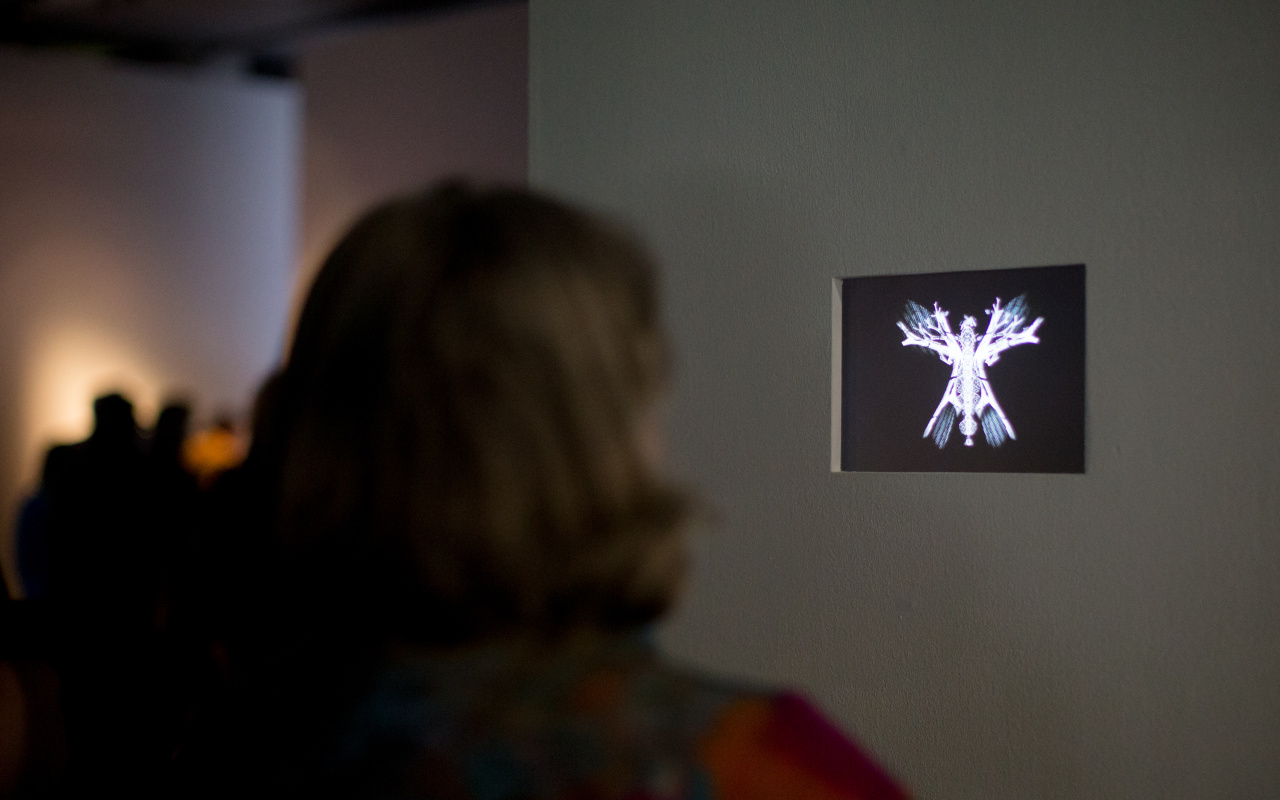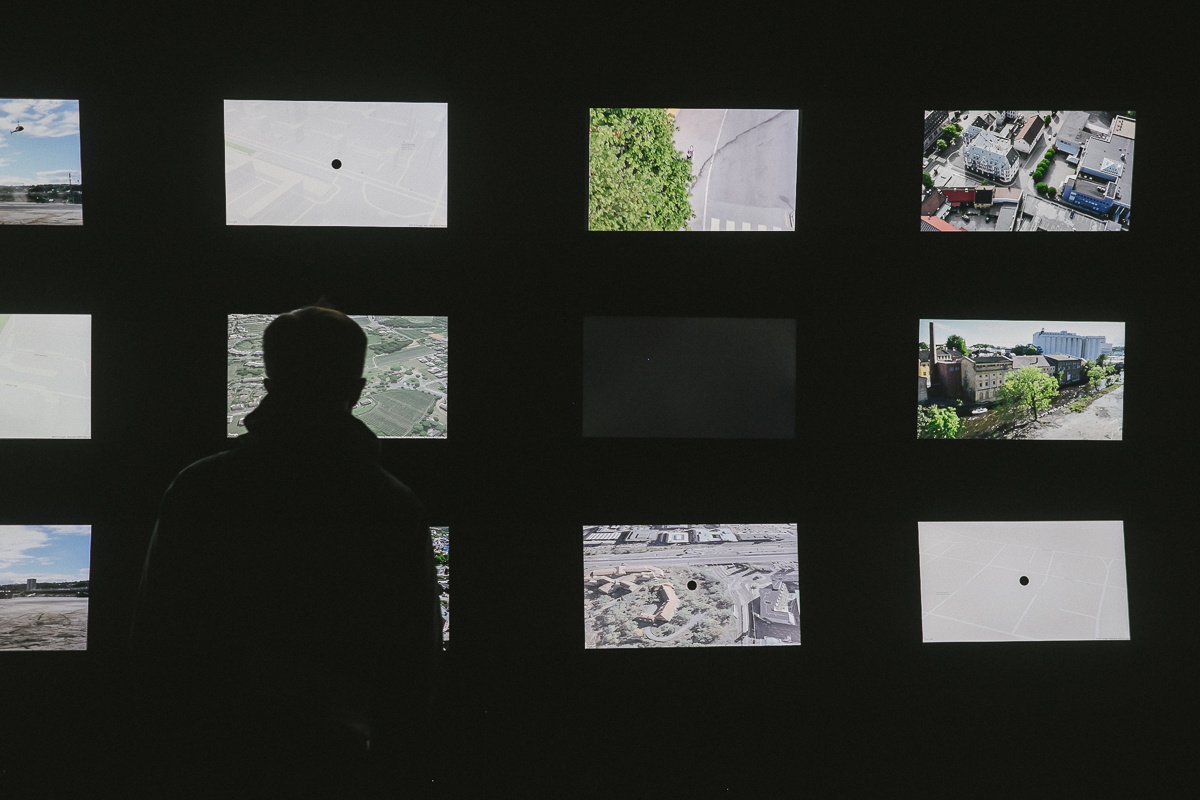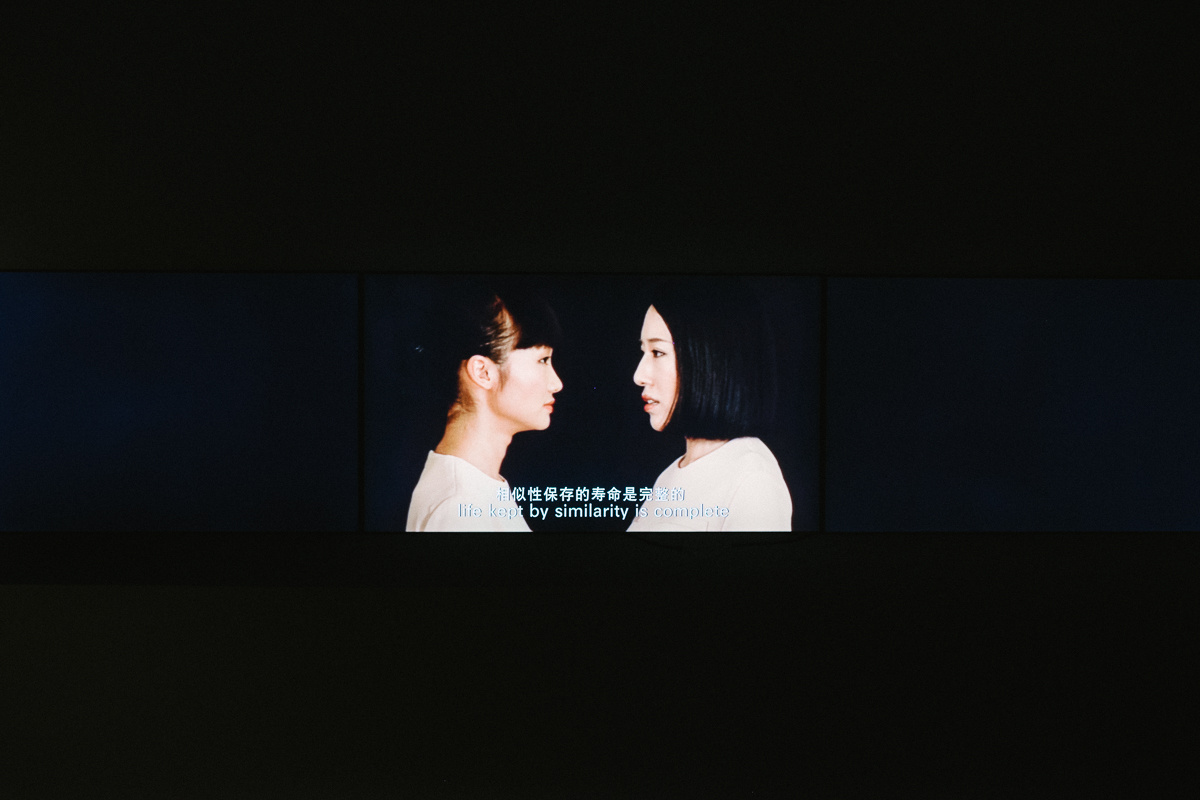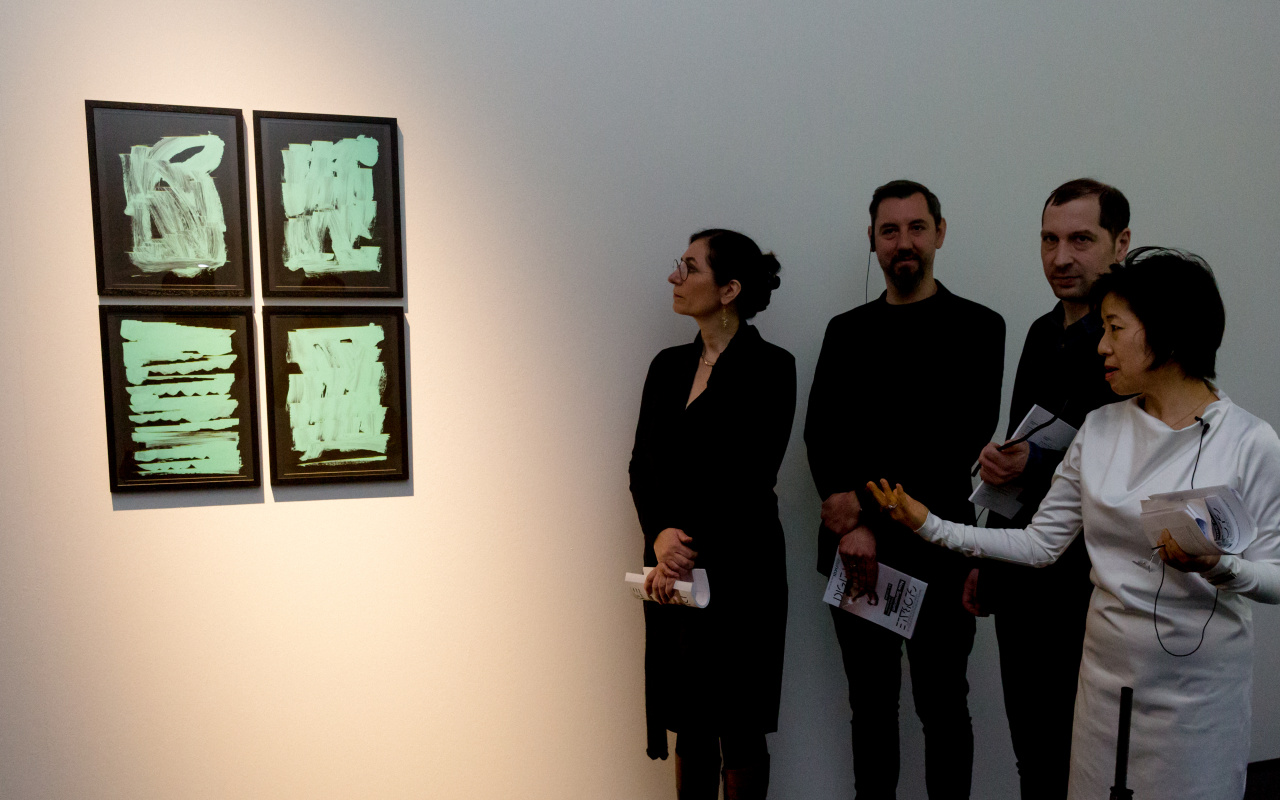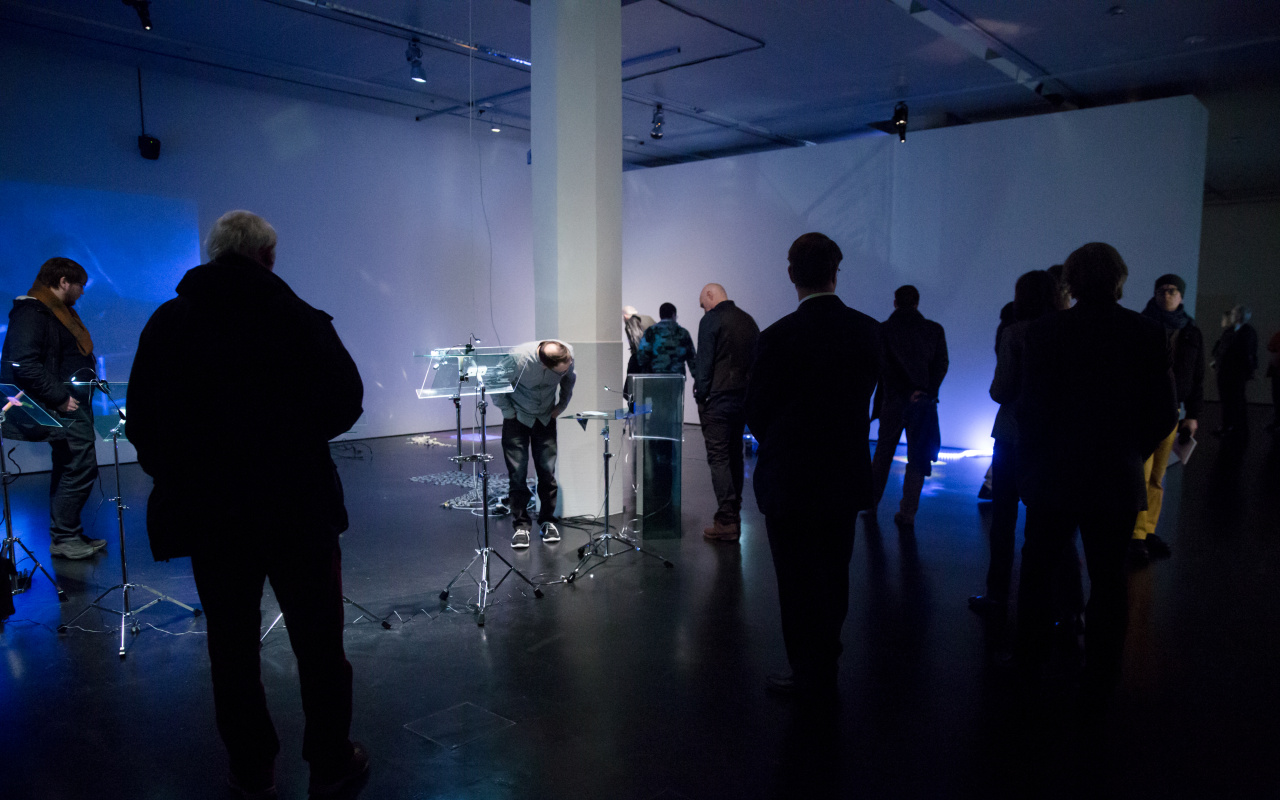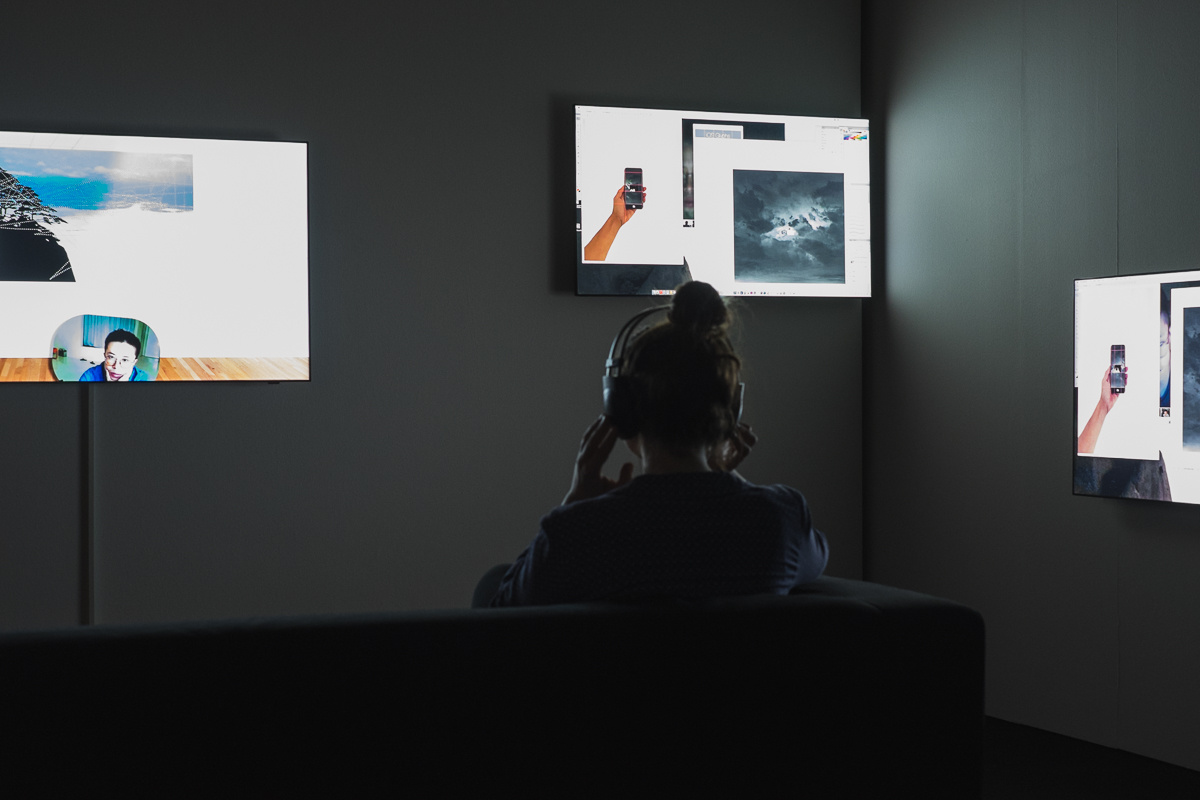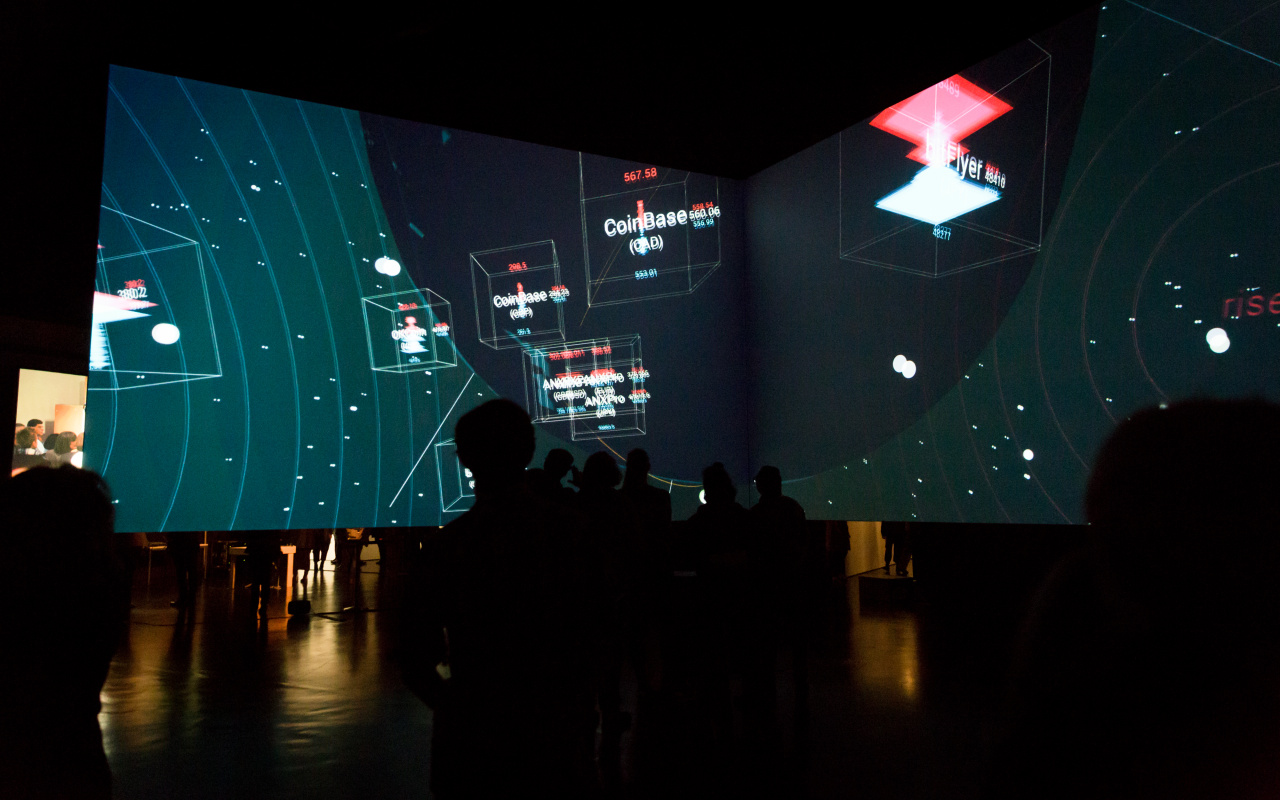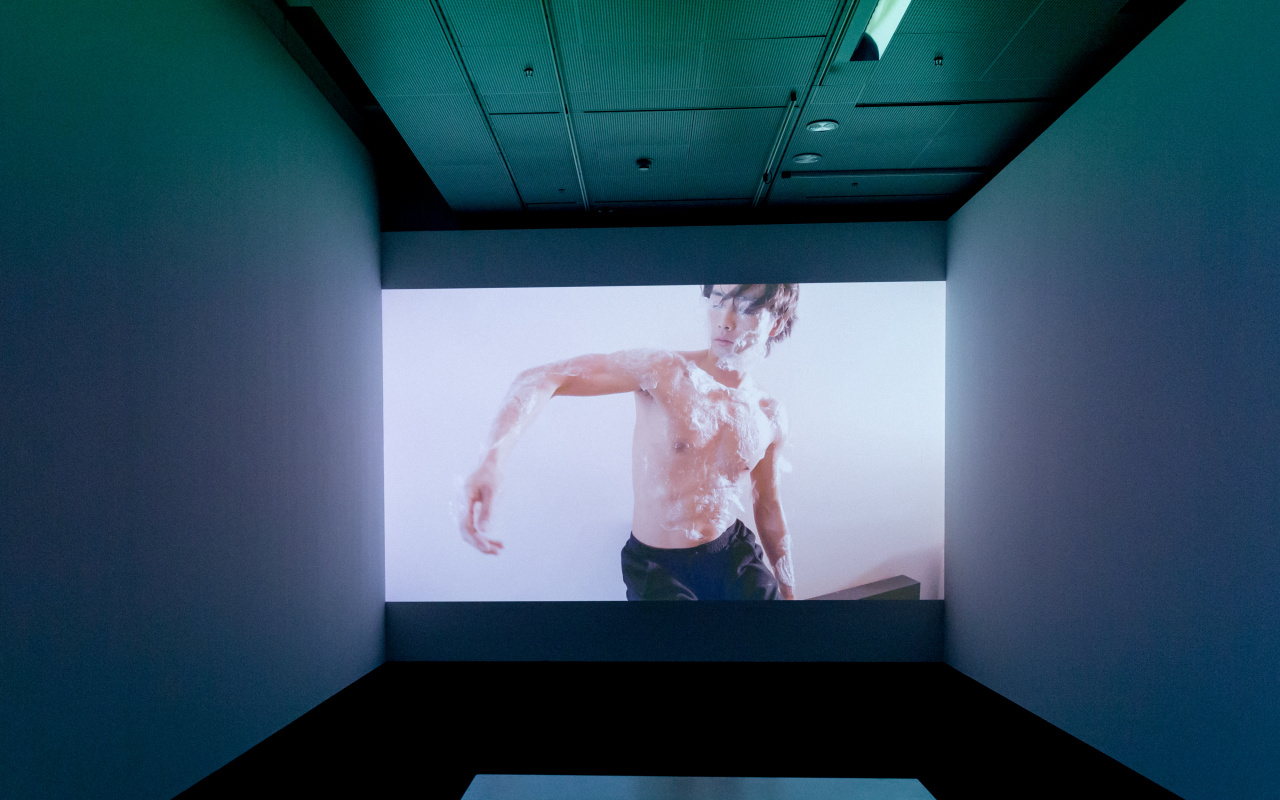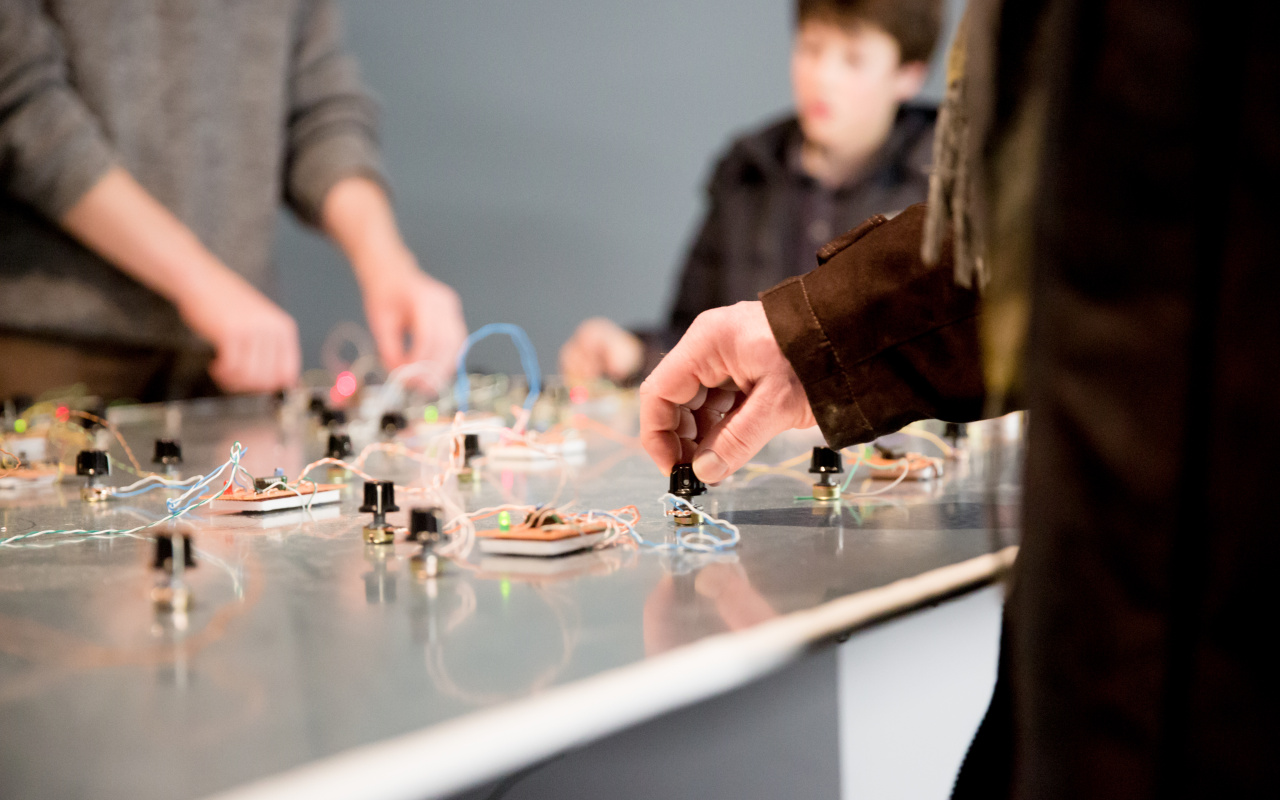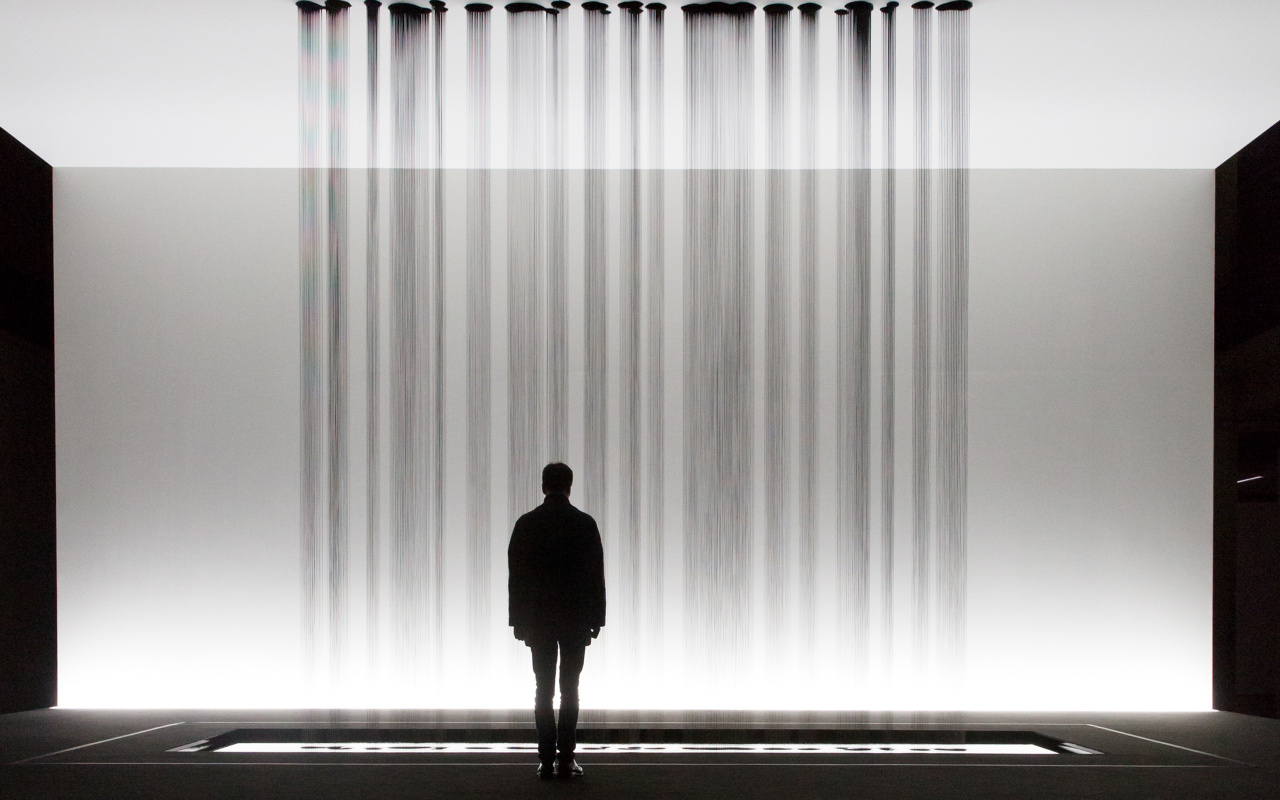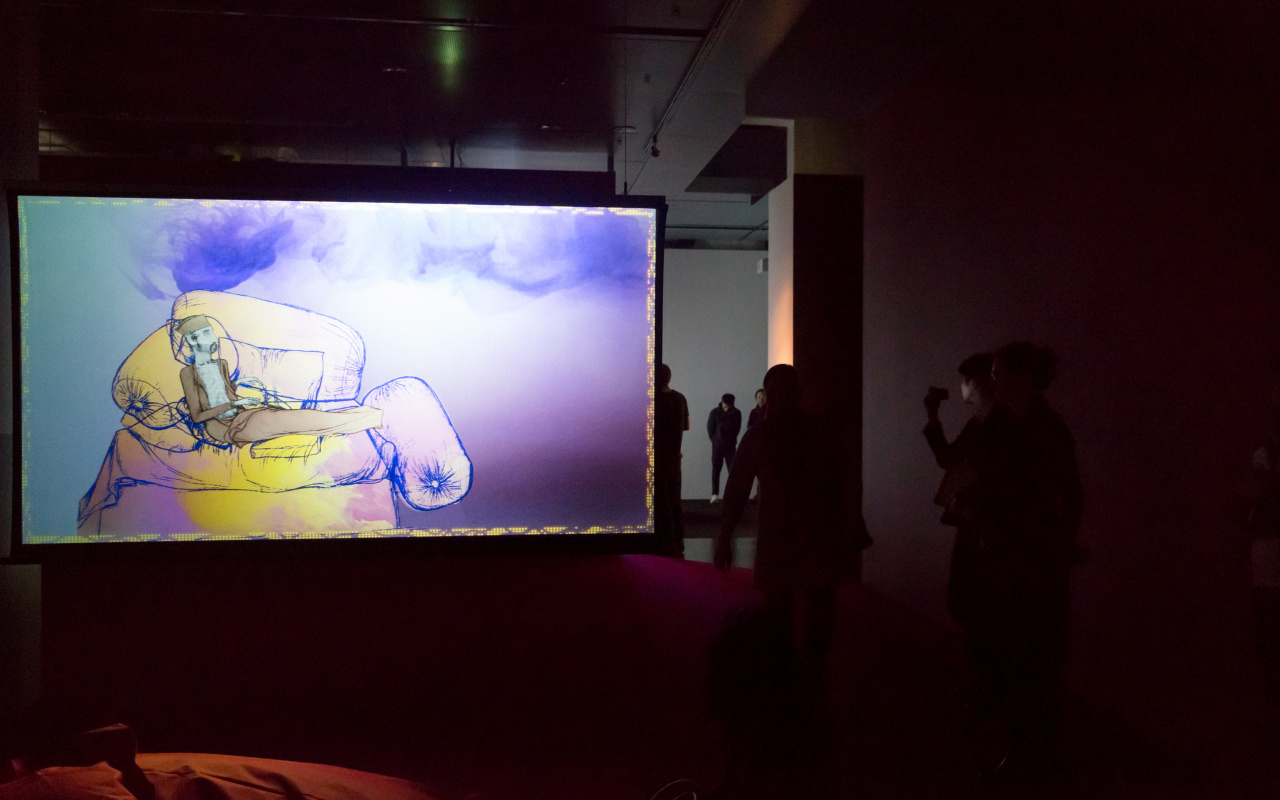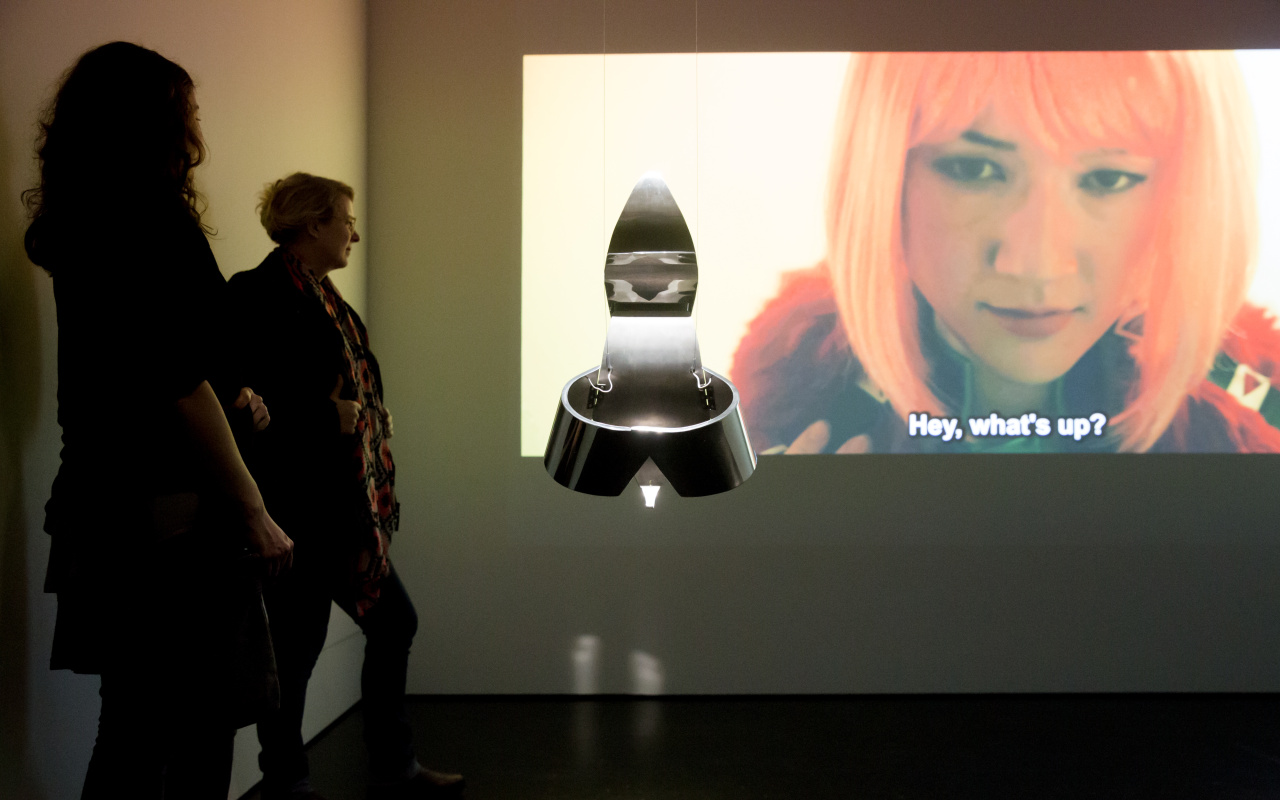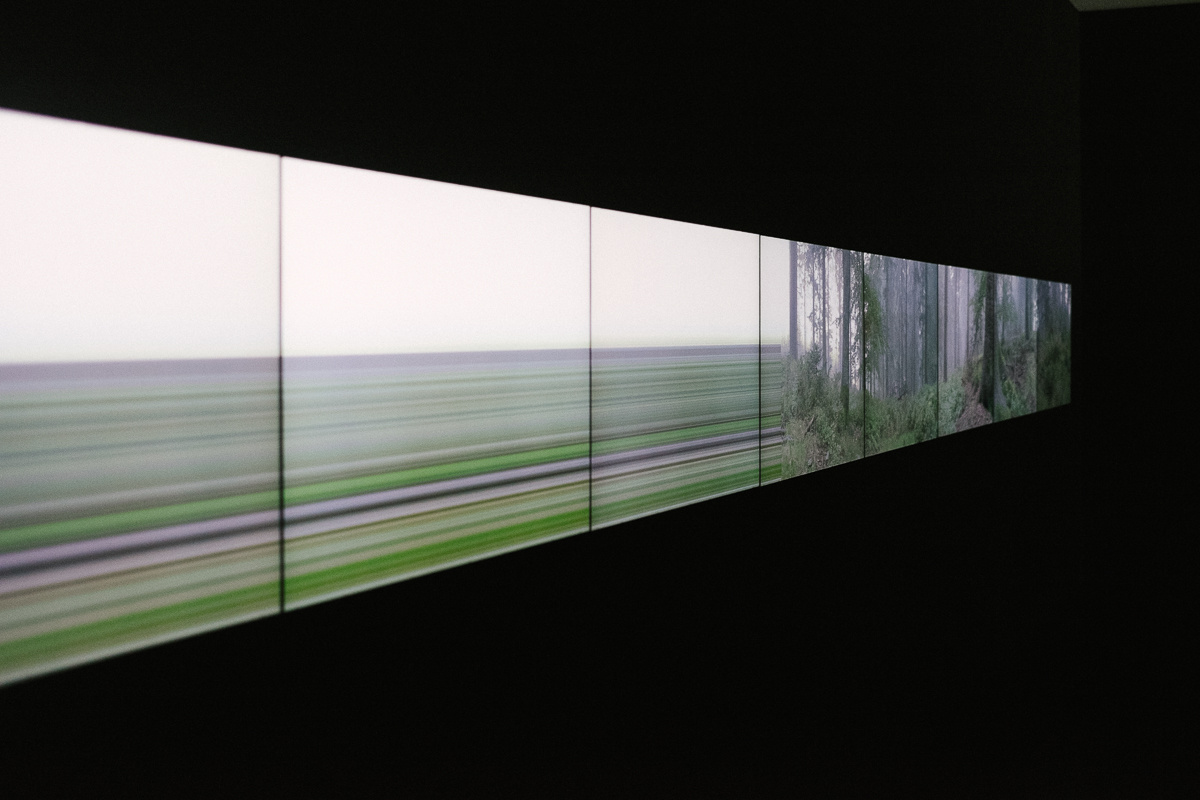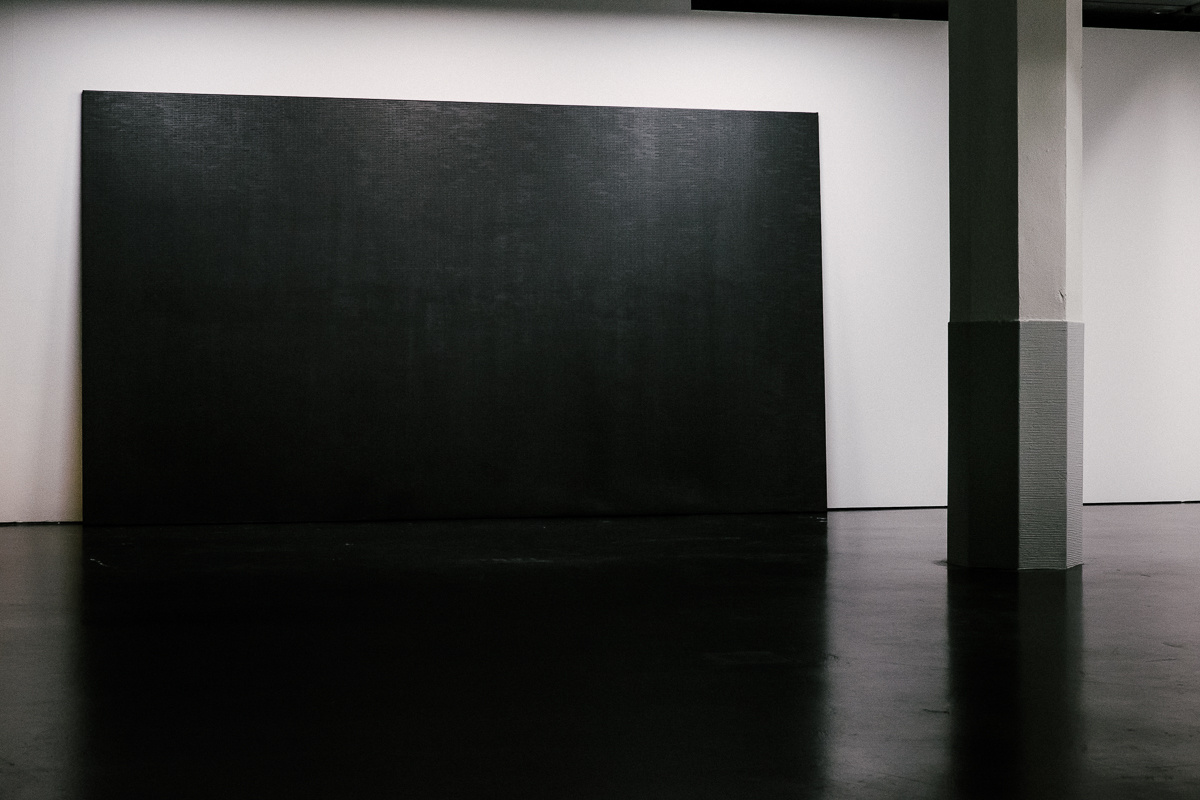Works of the Artists
New Sensorium
| Tarek Atoui »WITHIN« Rohini Devasher »Bloodlines«, »Doppelgänger« Valia Fetisov, Nicolay Spesivtsev and Dzina Zhuk »Paranoiapp« Guan Xiao »Reading«, »Cognitive Shape« Tara Kelton »Time Travel«, »Leonardo«, »Action Painting (200, 266, 400, 720)« Nile Koetting »Hard in Organics« Lin Ke »Link« Daito Manabe, Yusuke Tomoto and 2 bit Ishii »chains« |
Mirai Moriyama »Upload a New Mind to the Body« Magdi Mostafa »Transmission Loss« Kohei Nawa »Force« Bruce Quek »Auspex« Raqs Media Collective »Dyeing Inayat Khan« Sputniko! »The Moonwalk Machine – Selena's Step«, »Menstruation Machine – Takashi's Take« Shiro Takatani »Toposcan / Baden-Württemberg« Maria Taniguchi »Untitled (1), (3) and (4)«, »I See, It Feels« |
Over the past five years, Atoui has researched the relationships between sound as Vibration, instruments, and the bodies of the performer and the audience. This inquiry, encapsulated in his project »WITHIN«, which grew out of a 2008 residency at the Sharjah Art Foundation in the United Arab Emirates, culminated in his contribution to the Sharjah Biennial 11 in 2013. Throughout the course of his residency, he conducted Workshops at the AI Amal School for the Deaf in Sharjah, and in 2012, he joined forces with the research agency Council (founded by Gregory Castera and Sandra Terdjman), whose project »TACET« explores how deaf people experience and perceive sound. These different conversations formed the core of »WITHIN« and became the foundation of its artistic approach and conception.
For the exhibition »New Sensorium«, Tarek Atoui has continued his exploration into how the perception of sound by the deaf can infiuence our understanding of what hearing is and the way we think sound Performance – its space, instrumentation, and representation. In this context, Atoui has created an international transdisciplinary network of art institutions, universities, research centers, and artists for the building and imagining of musical instruments that address the deaf and the hearing alike. Two new instruments, the »Square Drum« by sound artist and composer Thierry Madiot, and the »SubBassProtoTon«, a walk-in Organ pipe – developed by Johannes Goebel, the founding director of the Institute for Music and Acoustics at ZKM | Karlsruhe – will be presented to the audience of the exhibition.
»WITHIN« at the exhibition »New Sensorium« will therefore explore and present the horizons this mediation opens, and how it affects the way hearing people play those instruments and work with them. Prior to ZKM, »WITHIN« took place between March and November 2015 at the Berkley Art Museum. In Berkley, two instruments were created in by Meyer Sound, Berkley Centre for New Media and Thierry Madiot (who's work is in the exhibition). Currently, the project is simultaneously taking place at the Experimental Media and Performing Art Center (EMPAC) at Rensselaer Polytechnic Institute (RPI) in Troy, New York, US and at the Bergen Assembly in Norway.
____________________________________________________________________»Bloodlines« (2009),
For the exhibition »New Sensorium«, Tarek Atoui has continued his exploration into how the perception of sound by the deaf can infiuence our understanding of what hearing is and the way we think sound Performance – its space, instrumentation, and representation. In this context, Atoui has created an international transdisciplinary network of art institutions, universities, research centers, and artists for the building and imagining of musical instruments that address the deaf and the hearing alike. Two new instruments, the »Square Drum« by sound artist and composer Thierry Madiot, and the »SubBassProtoTon«, a walk-in Organ pipe – developed by Johannes Goebel, the founding director of the Institute for Music and Acoustics at ZKM | Karlsruhe – will be presented to the audience of the exhibition.
»WITHIN« at the exhibition »New Sensorium« will therefore explore and present the horizons this mediation opens, and how it affects the way hearing people play those instruments and work with them. Prior to ZKM, »WITHIN« took place between March and November 2015 at the Berkley Art Museum. In Berkley, two instruments were created in by Meyer Sound, Berkley Centre for New Media and Thierry Madiot (who's work is in the exhibition). Currently, the project is simultaneously taking place at the Experimental Media and Performing Art Center (EMPAC) at Rensselaer Polytechnic Institute (RPI) in Troy, New York, US and at the Bergen Assembly in Norway.
____________________________________________________________________
Rohini Devasher
»Bloodlines« (2009),
»Doppelgänger« (2011)
Rohini Devasher works in a variety of media, including large site-specific drawings, video, digital printing, and sound. Her works are about complexity and how complexity is built into the natural order. Playing with organic boundaries and imaginary microcosms, »Bloodlines« and »Doppelgänger«, are distinct yet related motifs or episodes; each episode exploring the way complex morphological relationships can be explored via video feedback and recursion. This suite of works explores processes of growth and evolution through a technological matrix.
»Bloodlines« emerges from an idea put forward by evolutionary biologist Richard Dawkins in his book »The Blind Watchmaker« (1986) about "a warehouse full of impossible monsters..." Exploring the theory of cumulative selection, Dawkins asks us to imagine a huge grid, a massive hanger with an infinite number of shelves extending in all directions. »Bloodlines« begins with seven "parent" forms, each stemming from the gradual construction of an intricate skeletal structure made of individual, manually placed layers of video. The work introduces us to a family tree where each "parent" breeds a set of progeny, which in turn produce offspring of their own. The raw footage for the video was video feedback. In principle very similar to the old kaleidoscopes, video feedback is created when any ordinary hand-held camera is plugged into a TV and then made to point at itself. This footage is then sliced and edited by layering and manually stacking within a video-editing Software to create the work.
In »Doppelgänger«, two dragonflies, side by side, are "drawn" with lines of video-feedback. The forms are hybrid, deliberately layered and constructed to begin a new taxonomic structure. The two Videos are related yet distinct; »Doppelgänger I« charts a slow process of evolution gaining in complexity. »Doppelgänger II« explores the idea of invariant pattern linking variable detail, i.e. some elements such as the dragonfly's thorax remain constant while other structures such as wings, segmentation, etc. vary in detail. Both dragonflies go through several transitions, where in one case the form increases in complexity; while the other changes, sometimes subtly, sometimes drastically but always with the same basic structures in place.
____________________________________________________________________
»Bloodlines« emerges from an idea put forward by evolutionary biologist Richard Dawkins in his book »The Blind Watchmaker« (1986) about "a warehouse full of impossible monsters..." Exploring the theory of cumulative selection, Dawkins asks us to imagine a huge grid, a massive hanger with an infinite number of shelves extending in all directions. »Bloodlines« begins with seven "parent" forms, each stemming from the gradual construction of an intricate skeletal structure made of individual, manually placed layers of video. The work introduces us to a family tree where each "parent" breeds a set of progeny, which in turn produce offspring of their own. The raw footage for the video was video feedback. In principle very similar to the old kaleidoscopes, video feedback is created when any ordinary hand-held camera is plugged into a TV and then made to point at itself. This footage is then sliced and edited by layering and manually stacking within a video-editing Software to create the work.
In »Doppelgänger«, two dragonflies, side by side, are "drawn" with lines of video-feedback. The forms are hybrid, deliberately layered and constructed to begin a new taxonomic structure. The two Videos are related yet distinct; »Doppelgänger I« charts a slow process of evolution gaining in complexity. »Doppelgänger II« explores the idea of invariant pattern linking variable detail, i.e. some elements such as the dragonfly's thorax remain constant while other structures such as wings, segmentation, etc. vary in detail. Both dragonflies go through several transitions, where in one case the form increases in complexity; while the other changes, sometimes subtly, sometimes drastically but always with the same basic structures in place.
____________________________________________________________________
Valia Fetisov, Nicolay Spesivtsev and Dzina Zhuk
»Paranoiapp« (2015)
»Paranoiapp« is a social-psychology experiment combining a mobile application with an algorithm of users' interaction. Participants are invited to voluntarily explore fear by joining a Community of individuals, who are each potentially being followed by everyone else. For this purpose, the application continuously leaks one's geolocation, sending it to another user chosen by the algorithm.
By agreeing to the terms and conditions of »Paranoiapp«, one agrees to being watched. Every little change of location is collected, stored, analyzed, and sent to other users. You may be the one followed, you cannot know for sure. To induce fear on a city-wide scale, one or two people are chosen to be followed. Followers collaborate with each other in a chat, where they can discuss their target. Participation in the experiment requires installing »Paranoiapp« on one's mobile phone.
____________________________________________________________________»Reading« (2013),
By agreeing to the terms and conditions of »Paranoiapp«, one agrees to being watched. Every little change of location is collected, stored, analyzed, and sent to other users. You may be the one followed, you cannot know for sure. To induce fear on a city-wide scale, one or two people are chosen to be followed. Followers collaborate with each other in a chat, where they can discuss their target. Participation in the experiment requires installing »Paranoiapp« on one's mobile phone.
____________________________________________________________________
Guan Xiao
»Reading« (2013),
»Cognitive Shape« (2013)
Guan Xiao sees her art-making as a means to comment on the current image circulation enforced by digitality and globality. In her works, images are taken out of their original context and arranged according to a personal logic, so as to understand what it means to experience images from a global Standpoint. Her triptych video works and sculptural collages study the internal equivalence between object and subject, the old and the new, and the self and the other, from a view point that appears to be counter-intuitive.
The dreamy video essay »Reading« consists of two parts: on the left Channel, we see the visual rendition of a group of virtual pillars sliding down the frame from the top to the bottom; the essayistic lines on the right reads these visual materials in six chapters. In this gestural and rhythmic analysis of her artistic composition, the mixing of the visual ornaments from various sources eventually stop the viewers to conceive the possible origin of the visual material. Meanwhile, the subtitle in the right hand side described the message behind these compositions of the virtual objects in detail: repetition, hyperbole, analogy, and so on. Each has specific lines of thought regarding the production of meaning.
»Cognitive Shape« is the first film of Guan Xiao utilizing a triptych format, weaving various materials selected from her image database into a video essay. The artist has made herself acting as an indexical figure to narrate the cognitive process of seeing. In the video, there are lithic and technological objects descending in a row, or the fatalistic image of snake feeding vis-à-vis a clinical image of MRI scanning, explained with an artist's didactic tone, wearing a futuristic outfit. In such a way, it seems that even contemporary Utilities are infused with the prehistorical totem-liked aura. While her voice speculates on the cognitive condition with and without the conception of language, viewers would find her in later sequences testing her previous conclusion with her verbal interpretation, luring the audiences to view in the way she suggests.
____________________________________________________________________»Time Travel« (2009),
The dreamy video essay »Reading« consists of two parts: on the left Channel, we see the visual rendition of a group of virtual pillars sliding down the frame from the top to the bottom; the essayistic lines on the right reads these visual materials in six chapters. In this gestural and rhythmic analysis of her artistic composition, the mixing of the visual ornaments from various sources eventually stop the viewers to conceive the possible origin of the visual material. Meanwhile, the subtitle in the right hand side described the message behind these compositions of the virtual objects in detail: repetition, hyperbole, analogy, and so on. Each has specific lines of thought regarding the production of meaning.
»Cognitive Shape« is the first film of Guan Xiao utilizing a triptych format, weaving various materials selected from her image database into a video essay. The artist has made herself acting as an indexical figure to narrate the cognitive process of seeing. In the video, there are lithic and technological objects descending in a row, or the fatalistic image of snake feeding vis-à-vis a clinical image of MRI scanning, explained with an artist's didactic tone, wearing a futuristic outfit. In such a way, it seems that even contemporary Utilities are infused with the prehistorical totem-liked aura. While her voice speculates on the cognitive condition with and without the conception of language, viewers would find her in later sequences testing her previous conclusion with her verbal interpretation, luring the audiences to view in the way she suggests.
____________________________________________________________________
Tara Kelton
»Time Travel« (2009),
»Leonardo« (2011),
»Action Painting (200, 266, 400, 720)« (2015)
Tara Kelton's works investigate forms of drawing, and the relationship between human and machine, in light of new technology and tools of image production. Experiments and collaborations with digital labor, and processes typically involving relinquishing aesthetic control over the outcome, also form an important part of her work.
In »Leonardo«, the artist manipulates a portrait-"drawing" machine at a shopping mall by placing a mirror inside the portrait booth, causing the device to create its own portrait. As the machine creates the drawing (in reality a software program and filter that instantaneously processes the photo to make it appear hand-drawn), it displays a video on a screen inside the booth. In the video, an artist's "hand" is seen drawing and a pre-recorded voice (representing the voice of the artist) can be heard saying "uh-oh" when the hand makes a mistake, and, "What a masterpiece!" when it reviews its creation. After the video plays, the machine Outputs a drawing, signed "Leonardo".
ln »Action Painting«, the artist paints on the scanner surface while it is in motion, trying to catch the scanner light with a brush. This produces fragmented images with overlapping digital artifacts, as well as two simultaneous "recordings" – the artist's recording of the scanner light in paint, and the digital record of the moving hand of the artist.
In »Time Travel«, the artist used a video camera and a laptop to explore time travel on a train from Bangalore to Bangarapet. At the front of a train car, she installed a video camera pointed out the door. The live video feed from this camera was sent to her laptop placed in front of a second door at the back of the train car. While viewing the laptop, she was able to see approximately one tenth of a second into the future. The work is a sincere attempt at achieving the physically impossible, using a simple apparatus. For a split second, viewers wonder whether they are truly time traveling, before realizing that it isn't the future they are experiencing, but a possible version of the future - or someone else's present. Situating the piece on a commuter train heightens the daily sensation of traveling through two places at one time, or through two times at one place, or both.
____________________________________________________________________
In »Leonardo«, the artist manipulates a portrait-"drawing" machine at a shopping mall by placing a mirror inside the portrait booth, causing the device to create its own portrait. As the machine creates the drawing (in reality a software program and filter that instantaneously processes the photo to make it appear hand-drawn), it displays a video on a screen inside the booth. In the video, an artist's "hand" is seen drawing and a pre-recorded voice (representing the voice of the artist) can be heard saying "uh-oh" when the hand makes a mistake, and, "What a masterpiece!" when it reviews its creation. After the video plays, the machine Outputs a drawing, signed "Leonardo".
ln »Action Painting«, the artist paints on the scanner surface while it is in motion, trying to catch the scanner light with a brush. This produces fragmented images with overlapping digital artifacts, as well as two simultaneous "recordings" – the artist's recording of the scanner light in paint, and the digital record of the moving hand of the artist.
In »Time Travel«, the artist used a video camera and a laptop to explore time travel on a train from Bangalore to Bangarapet. At the front of a train car, she installed a video camera pointed out the door. The live video feed from this camera was sent to her laptop placed in front of a second door at the back of the train car. While viewing the laptop, she was able to see approximately one tenth of a second into the future. The work is a sincere attempt at achieving the physically impossible, using a simple apparatus. For a split second, viewers wonder whether they are truly time traveling, before realizing that it isn't the future they are experiencing, but a possible version of the future - or someone else's present. Situating the piece on a commuter train heightens the daily sensation of traveling through two places at one time, or through two times at one place, or both.
____________________________________________________________________
Nile Koetting
»Hard in Organics« (2015–2016)
The works of Nile Koetting share the continuing theme of "sensing"; using a diverse range of media, including Performance, sound, installation, and scientific materials. Derived from Koetting's experience as a stage performer, they constantly reflect ideas of theatrical structure. They evoke a new perspective, as well as a landscape of "being" in our civilization and environment. One of the most important achievements of Pierre Curie, the famous French scientist and husband of Marie Curie, was the discovery of the symmetry of crystalline structures and the piezoelectric effect. The piezoelectric effect of certain crystals was subsequently applied as the basic mechanism for sensors and Speakers. During World War II, Curie's discovery was put to effective use in numerous types of communications equipment.
Niele Koetting's installation »Hard in Organics« uses crystals, video, and sound to reference relationships of ways to apprehend the body. Part of the installation is Koetting's video piece »Deep Signals« (2015), showing six women on their respective voyages of body exploration, at a radio station once operated by the former German Democratic Republic. Their actions probe a never-ending horizon extending outward from a central point, as opposed to moving back and forth in vertical flights between an upper, divine level and a Iower, animal one. The sound sculptures exhibited around the video – which include a piece applying electrified crystal, a sculpture made out of numerous pressure sensors, and a sheet of electrified tin foil printed with one of Pierre Curie's love letters to Marie – generate an entire soundscape that merges into the theatrical and musical space.
The Italian philosopher Mario Perniola has stated: "Music, after all, is the sound generated from the movement of attraction of bodies be-come things. The distorted sounds constantly emanating from these mediums and the gravity of their bodies are attracting and mesmerizing something. What is body, and how can corporeality be translated into the language of other disciplines? And how can it resonate and generate "music"? »Hard in Organics« explores a new perspective on the relationship between "organic" versus "inorganic" and, by doing so, writes a new narrative of living and non-living beings.
____________________________________________________________________
Niele Koetting's installation »Hard in Organics« uses crystals, video, and sound to reference relationships of ways to apprehend the body. Part of the installation is Koetting's video piece »Deep Signals« (2015), showing six women on their respective voyages of body exploration, at a radio station once operated by the former German Democratic Republic. Their actions probe a never-ending horizon extending outward from a central point, as opposed to moving back and forth in vertical flights between an upper, divine level and a Iower, animal one. The sound sculptures exhibited around the video – which include a piece applying electrified crystal, a sculpture made out of numerous pressure sensors, and a sheet of electrified tin foil printed with one of Pierre Curie's love letters to Marie – generate an entire soundscape that merges into the theatrical and musical space.
The Italian philosopher Mario Perniola has stated: "Music, after all, is the sound generated from the movement of attraction of bodies be-come things. The distorted sounds constantly emanating from these mediums and the gravity of their bodies are attracting and mesmerizing something. What is body, and how can corporeality be translated into the language of other disciplines? And how can it resonate and generate "music"? »Hard in Organics« explores a new perspective on the relationship between "organic" versus "inorganic" and, by doing so, writes a new narrative of living and non-living beings.
____________________________________________________________________
Lin Ke
»Link« (2011–2015)
Combining sixteen video pieces, played in order via projector as if playing a series of films, and four independent videos played via television – welcome to "link" world. The Chinese pronunciation of my name, Lin Ke, is similar to the English word "link". This coincidence corresponds to how I make my art-works – mouse-clicking to link all kinds of random images, thus keeping a record of my thoughts. In computer operating systems, behind each movement we make lies a series of hidden codes. Clicking the links that appear in windows allows a part of myself, my hand, to extend into the digital world. Without a mouse and keyboard, I can't capture them.
The names of my pieces have no meaning, only some suggest a concept. These titles are: »Robinson Crusoe« (a hard drive drifting in the ocean), »Pu« (the sound of a fart made with the mouth, for creative file folders), »swing swing« (a rotating marquee around the moon, with dancing music, makes it more like a disc) »Today« (daylight changes during a day, by means of Photoshop), »Traditional Romance« (with romantic background music, using Photoshop to alter the lights in an exhibition space), »Fire Desktop« (desktop file folder is on fire, but it's okay), »Star Travel« (2013) (in a star-filled image clicking a few points into several lines simulates space travel), »Wind of Virtual Memory« (to the sound of waves, sails are moved, by the heart or the wind?), »lightning01« (a Macmade selfie is another kind of lightning), »Download Rain No. 02« (waiting for a download is like waiting for the rain to stop), »Beach of Tokyo« (I want music about the future, based on classical music, with an electronic amplifier), »Engineer« (a selfie could drift around the Earth, each mouse-click being a spaceship), »Moon Light« (ancient Chinese poets love to make poetry in moonlight), »Lens from E-world« (a programmer is also a pianist), »+« (the symbol"+" is the Sacred Heart of Jesus, pain-filled), »Moon« (the moon is a spaceship itself), »Watching 01« and »Watching 02« (of course I am behind you), »Lightning02« (taking a selfie at night) and »Helmsman« (for Daft Punk and StarTrek).
____________________________________________________________________
The names of my pieces have no meaning, only some suggest a concept. These titles are: »Robinson Crusoe« (a hard drive drifting in the ocean), »Pu« (the sound of a fart made with the mouth, for creative file folders), »swing swing« (a rotating marquee around the moon, with dancing music, makes it more like a disc) »Today« (daylight changes during a day, by means of Photoshop), »Traditional Romance« (with romantic background music, using Photoshop to alter the lights in an exhibition space), »Fire Desktop« (desktop file folder is on fire, but it's okay), »Star Travel« (2013) (in a star-filled image clicking a few points into several lines simulates space travel), »Wind of Virtual Memory« (to the sound of waves, sails are moved, by the heart or the wind?), »lightning01« (a Macmade selfie is another kind of lightning), »Download Rain No. 02« (waiting for a download is like waiting for the rain to stop), »Beach of Tokyo« (I want music about the future, based on classical music, with an electronic amplifier), »Engineer« (a selfie could drift around the Earth, each mouse-click being a spaceship), »Moon Light« (ancient Chinese poets love to make poetry in moonlight), »Lens from E-world« (a programmer is also a pianist), »+« (the symbol"+" is the Sacred Heart of Jesus, pain-filled), »Moon« (the moon is a spaceship itself), »Watching 01« and »Watching 02« (of course I am behind you), »Lightning02« (taking a selfie at night) and »Helmsman« (for Daft Punk and StarTrek).
____________________________________________________________________
Daito Manabe, Yusuke Tomoto and 2 bit Ishii
»chains« (2016)
In recent years, public interest in blockchain technology has grown along with the rise of the buzzword "fintech" on Google Trends. One of the most successful uses of blockchain is the cryptocurrency bitcoin. Bitcoin does not depend on a central agency, as does conventional legal tender, and because it can perform highly anonymous transactions across borders, it has created a new mechanism for business activities. At the same time, critics have pointed out its potential for such misuse as money laundering and financing for anti-social groups. Accordingly, its treatment differs from country to country. It still has problems even though it has already been implemented in society; for example, one of bitcoin's main former developers says that mining is also carried out by some private individuals.
For their work »chains«, the artists have developed and displayed visualization for studying blockchain, along with an automated trading system. Additionally, the work examines a platform for digital artworks involving original currency using blockchain.
____________________________________________________________________
For their work »chains«, the artists have developed and displayed visualization for studying blockchain, along with an automated trading system. Additionally, the work examines a platform for digital artworks involving original currency using blockchain.
____________________________________________________________________
Mirai Moriyama
»Upload a New Mind to the Body« (2016)
Mirai Moriyama is trained in a number of dance disciplines, including jazz, tap, classical ballet, and hip-hop, and also as an actor on stage and film. His recent development has led him to work across multiple artistic genres and spaces. He uses his physical skills to play diverse non-human characters, such as cats, insects, or robots. In his investigations of the hybridity of the digital and analog body, he seeks to embody the idea of a new sensorium on a certain hyperlevel.
His solo Performance »Upload a New Mind to the Body«, an original production for this exhibition, aims to eliminate the boundaries of subject and object. Mirai Moriyama will wear a membrane, which represents an existing operating system (OS). It dries and peels off as a result of his intense body movements, as if a newly uploaded operating system conflicted with the existing settings. The sound piece accompanying the performance deconstructs the name of the performer into the syllables »MO-RI-YA-MA-MI-RA-I«, adding a dadaistic gesture to the performance. The video work, bearing the same title, follows the performance's concept. A special camera captures a detailed view of his skin surface and precise body movements in a representation of transitional time / space.
____________________________________________________________________
His solo Performance »Upload a New Mind to the Body«, an original production for this exhibition, aims to eliminate the boundaries of subject and object. Mirai Moriyama will wear a membrane, which represents an existing operating system (OS). It dries and peels off as a result of his intense body movements, as if a newly uploaded operating system conflicted with the existing settings. The sound piece accompanying the performance deconstructs the name of the performer into the syllables »MO-RI-YA-MA-MI-RA-I«, adding a dadaistic gesture to the performance. The video work, bearing the same title, follows the performance's concept. A special camera captures a detailed view of his skin surface and precise body movements in a representation of transitional time / space.
____________________________________________________________________
Magdi Mostafa
»Transmission Loss« (2016)
The dialog between sound and space is central to Magdi Mostafa's work. The initial generator of the concept is space (architectural, urban, private, public, dreamed, or real space), while sound has an intensely powerful ability to reconstruct past experiences, evoking different images or moods with little more than a minor change in value or tone. In its exploration of the conceptual relationship between sound and space, his work navigates the rapid transformations of the surroundings, mapping the effects of "modernity" on local traditions, on the phenomenological experience of the individual in the city and interpersonal relationships. As part and parcel of these interests, it often involves the evocation of personal or shared memories, recalling, for instance, outmoded technological innovations, or engaging with the historical past of a certain public space.
»Transmission Loss« is a new part of the artist's investigations in creating dynamic, variable-scaled, vibration-based sound sculptures. This project is also an extension of his previous work, »Sound Cells (Analog frequencies)«, shown in Cairo 2009, which sparked the artist's on-going research in circuit-making skills and combining simple vintage sound devices. The term "transmission loss" is by definition (mostly in acoustics) the difference between the sound energy at the source of transmission and that at the transmission receiver, within the sonic environment; and is mostly used in broadcasting and information/communication technology. Here, the concept is a poetic one, referring to a sort of "bemoaning," or a manifestation of a certain "absence" that we don't know during the process of generating these sounds. It might be the absence of time, which has to do with abandonment technologies, or the absence of our understanding of these values of sound itself, or even both.
____________________________________________________________________
»Transmission Loss« is a new part of the artist's investigations in creating dynamic, variable-scaled, vibration-based sound sculptures. This project is also an extension of his previous work, »Sound Cells (Analog frequencies)«, shown in Cairo 2009, which sparked the artist's on-going research in circuit-making skills and combining simple vintage sound devices. The term "transmission loss" is by definition (mostly in acoustics) the difference between the sound energy at the source of transmission and that at the transmission receiver, within the sonic environment; and is mostly used in broadcasting and information/communication technology. Here, the concept is a poetic one, referring to a sort of "bemoaning," or a manifestation of a certain "absence" that we don't know during the process of generating these sounds. It might be the absence of time, which has to do with abandonment technologies, or the absence of our understanding of these values of sound itself, or even both.
____________________________________________________________________
Kohei Nawa
»Force« (2015)
In his artwork Kohei Nawa deals with the question about seeing things in a new light. Everyday objects are coated for example with a layer of transparent glass beads. The glass beads give a new skin to the pieces and convert them into an abstract new object. By covering up the everyday objects the artist motivates an intensive interaction between the spectators and the objects asking about the object's fundamental existence. He is playing with illusions and the spectator's perception regarding a new reception of reality.
»Force« is an installation operating with such physical phenomena as gravity and inertia. The force of gravity is visualized through the interaction between gravity and a liquid with carefully computed qualities. In the installation, black silicone oil, engineered in the studio to achieve the required viscosity, streams continuously from the ceiling to the floor, where a pool of black rain forms. By blurring the distinction between the characteristics of solids and liquids, this conveys the impression of a sculpture transformed into a liquid – and vice versa. Through this visualization of an on-going moment, »Force« inspires the awareness that we are caught within time, space, and materiality at every present moment.
____________________________________________________________________
»Force« is an installation operating with such physical phenomena as gravity and inertia. The force of gravity is visualized through the interaction between gravity and a liquid with carefully computed qualities. In the installation, black silicone oil, engineered in the studio to achieve the required viscosity, streams continuously from the ceiling to the floor, where a pool of black rain forms. By blurring the distinction between the characteristics of solids and liquids, this conveys the impression of a sculpture transformed into a liquid – and vice versa. Through this visualization of an on-going moment, »Force« inspires the awareness that we are caught within time, space, and materiality at every present moment.
____________________________________________________________________
Bruce Quek
»Auspex« (2016)
The driving force underlying Quek's recent work remains an obsession with cities – these super-dense concatenations of infrastructure (both street and hyperlink), which define us as much as we define them. This obsession stems in turn from William Gibson's own interest in the Walled City of Kowloon as a sort of exemplary city – compounding generations of ad hoc organic growth, from which emerge the sort of strangeness and serendipity that would be all but impossible in a non-urban environment. In essence, the artist is driven to understand the possibilities and consequences that emerge from human populations being enmeshed in physical and informational networks of exponentially increasing density.
This overriding obsession is most evident in two major series by the artist, »The Hall of Minors« (ongoing, from 2011), and the »Consider();« series (ongoing, from 2013). The »Hall of Minors« addresses the limits of empathy in an age of informational supersaturation (and the hollowness of art-activist responses to it), in the form of a collection of clocks ceaselessly chiming the rates of occurrence of all manner of atrocities – rapes, murders, deaths by preventable disease, ecological catastrophes, et cetera. The »Consider();« series, which may be seen as the direct forerunner of »Auspex«, poses a simple question: What if the roles – both mythopoeic and mundane – of the stars had been supplanted by our own constellations of artificial lights?
»Auspex« continues the artist's enquiry into the intersection of human pattern-recognizing habits with our technological society, turning our eye to the sky to project meaning onto the patterns etched onto it every day. With its absurd proposition that meaning may be derived from or projected onto aircraft contrails, »Auspex« aims to create a process inducing the repetitive and monotonous experience of abnormal meanings, within that given experiential field, to the point of solipsistic delusion.
____________________________________________________________________
This overriding obsession is most evident in two major series by the artist, »The Hall of Minors« (ongoing, from 2011), and the »Consider();« series (ongoing, from 2013). The »Hall of Minors« addresses the limits of empathy in an age of informational supersaturation (and the hollowness of art-activist responses to it), in the form of a collection of clocks ceaselessly chiming the rates of occurrence of all manner of atrocities – rapes, murders, deaths by preventable disease, ecological catastrophes, et cetera. The »Consider();« series, which may be seen as the direct forerunner of »Auspex«, poses a simple question: What if the roles – both mythopoeic and mundane – of the stars had been supplanted by our own constellations of artificial lights?
»Auspex« continues the artist's enquiry into the intersection of human pattern-recognizing habits with our technological society, turning our eye to the sky to project meaning onto the patterns etched onto it every day. With its absurd proposition that meaning may be derived from or projected onto aircraft contrails, »Auspex« aims to create a process inducing the repetitive and monotonous experience of abnormal meanings, within that given experiential field, to the point of solipsistic delusion.
____________________________________________________________________
Raqs Media Collective
»Dyeing Inayat Khan« (2016)
The Raqs Media Collective enjoys playing a plurality of roles, often appearing as artists, occasionally as curators, sometimes as philosophical agent provocateurs. While mainly producing contemporary fine art, the members of the collective have also made films, curated exhibitions, edited books, staged events, collaborated with architects, computer programmers, writers, and theater directors, and have founded processes that have left deep impacts on contemporary culture in India.
With »Dyeing Inayat Khan«, Raqs extend their practice of intervening with video in archival and historical traces. The video diptych is an animation of a facsimile of a drawing for a Mughal miniature – translating "animation" into a mode of traversing the threshold between life and death, between being animate and being inanimate. By breathing life into a seventeenth century portrait of a dying man from the Mughal Court, Raqs offer a meditation on what life (luminous, desiring) means in the context of the passage of time and the inevitability of mortality.
The original drawing is an early seventeenth Century drawing in the Mughal miniature style attributed to Balchand, an artist from the atelier of the court of the Mughal emperor Jahangir. The drawing is a study for a portrait of a dying nobleman named Inayat Khan. It shows the dose court official on his deathbed, ravaged by opium and alcohol addiction. For Mughal emperor Jahangir, the spectacle of Inayat Khan's emaciated body was both a curiosity and a warning. In his memoirs, he described the dying man in the drawing as being in a State of passing over into the realm of non-existence. Today the drawing is found in the collection of the Museum of Fine Art, Boston.
____________________________________________________________________»The Moonwalk Machine – Selena's Step« (2013),
With »Dyeing Inayat Khan«, Raqs extend their practice of intervening with video in archival and historical traces. The video diptych is an animation of a facsimile of a drawing for a Mughal miniature – translating "animation" into a mode of traversing the threshold between life and death, between being animate and being inanimate. By breathing life into a seventeenth century portrait of a dying man from the Mughal Court, Raqs offer a meditation on what life (luminous, desiring) means in the context of the passage of time and the inevitability of mortality.
The original drawing is an early seventeenth Century drawing in the Mughal miniature style attributed to Balchand, an artist from the atelier of the court of the Mughal emperor Jahangir. The drawing is a study for a portrait of a dying nobleman named Inayat Khan. It shows the dose court official on his deathbed, ravaged by opium and alcohol addiction. For Mughal emperor Jahangir, the spectacle of Inayat Khan's emaciated body was both a curiosity and a warning. In his memoirs, he described the dying man in the drawing as being in a State of passing over into the realm of non-existence. Today the drawing is found in the collection of the Museum of Fine Art, Boston.
____________________________________________________________________
Sputniko!
»The Moonwalk Machine – Selena's Step« (2013),
»Menstruation Machine – Takashi's Take« (2010)
»The Moonwalk Machine - Selena's Step« unravels a story about the protagonist Selena, a science geek girl, who invents a lunar rover rigged with high-heels, in the hope of leaving her marks as the first female steps on the surface of the moon. The installation includes an image of a super heroine – Lunar Girl – which Selena dreams of becoming, as well as the actual lunar rover. With input from engineers and specialists at NASA's Johnson Space Center in Houston, the machine was designed to leave high-heel marks firmly imprinted on the moon's surface – suggesting that the next "giant leap for mankind" might be in the not so distant future, not for the sake of winning the space race, but for the fulfillment of a personal, romantic wish.
»The Menstruation Machine« deals with an intriguing question. As a female artist, Sputniko! wanted to know: Why are humans still menstruating? When the contraceptive pill was launched commercially in the 1960s, the regimen deliberately provided for a monthly pill-free week of menstruation. The doctors felt that users would find the loss of their periods worrisome and unacceptable. Fifty years further along, modern technology has accomplished so much more – space travel, mobile phones, the Internet, cloning, and genetically modified foods – but women are still bleeding. Clearly, the advancement of technology is heavily influenced by prevailing political, social, and cultural backgrounds. So what does menstruation mean, biologically, culturally, and historically, to humans? Who might choose to have it, and how might they have it? »The Menstruation Machine« – fitted with a blood dispensing mechanism and electrodes stimulating the lower abdomen – simulates the pain and bleeding of a five-day menstruation process. In the music video, a Japanese transvestite boy named Takashi builds and wears the machine to fulfill his desire to understand what a period feels like to his female friends. The music video was posted on YouTube to trigger reaction from a wide audience, outside of the traditional gallery environment. It was immediately posted on influential blogs, and the story of Takashi's desire to menstruate created a viral frenzy of debates, resulting in 100,000 YouTube hits in a mere week.
____________________________________________________________________
»The Menstruation Machine« deals with an intriguing question. As a female artist, Sputniko! wanted to know: Why are humans still menstruating? When the contraceptive pill was launched commercially in the 1960s, the regimen deliberately provided for a monthly pill-free week of menstruation. The doctors felt that users would find the loss of their periods worrisome and unacceptable. Fifty years further along, modern technology has accomplished so much more – space travel, mobile phones, the Internet, cloning, and genetically modified foods – but women are still bleeding. Clearly, the advancement of technology is heavily influenced by prevailing political, social, and cultural backgrounds. So what does menstruation mean, biologically, culturally, and historically, to humans? Who might choose to have it, and how might they have it? »The Menstruation Machine« – fitted with a blood dispensing mechanism and electrodes stimulating the lower abdomen – simulates the pain and bleeding of a five-day menstruation process. In the music video, a Japanese transvestite boy named Takashi builds and wears the machine to fulfill his desire to understand what a period feels like to his female friends. The music video was posted on YouTube to trigger reaction from a wide audience, outside of the traditional gallery environment. It was immediately posted on influential blogs, and the story of Takashi's desire to menstruate created a viral frenzy of debates, resulting in 100,000 YouTube hits in a mere week.
____________________________________________________________________
Shiro Takatani
»Toposcan / Baden-Württemberg« (2016)
This installation is an experimental simulation of non-human vision, showing both: time as movement (transposition) and time as accumulation (Sedimentation). Source imagery from a 360° sweeping panoramic video forms a moving image "window" that slowly travels left-to-right across a bank of eight 16:9 ratio monitors. As the window advances, the single-pixel left edge stretches out into a trail of horizontal bands. Then, as the window moves back right-to-left, the right edge deposits pixel-width vertical freeze-frame stripes, creating an incremental build-up of instant-by-instant image delays. Unlike how the human eye sees, the work thus combines three different visual formats – horizontal bands that ultimately form a landscape, sweeping landscape footage, and still delays from the panning footage – rather more akin to such optical devices as scanners and copy machines, which translate objects into lines, or cameras, which capture pictorial space without the depth or vanishing points of linear perspective.
Shiro Takatani developed »Toposcan / Baden-Württemberg« in collaboration with ZKM | Karlsruhe. It is a new version of an ongoing series, specially produced for »New Sensorium. Exiting from Failures of Modernization«.
____________________________________________________________________»Untitled (1)« (2015),
Shiro Takatani developed »Toposcan / Baden-Württemberg« in collaboration with ZKM | Karlsruhe. It is a new version of an ongoing series, specially produced for »New Sensorium. Exiting from Failures of Modernization«.
____________________________________________________________________
Maria Taniguchi
»Untitled (1)« (2015),
»Untitled (3)« (2014),
»Untitled (4)« (2015),
»I See, It Feels« (2015)
Maria Taniguchi's paintings and videos draw attention to acts of composing, constructing, and framing. Her ongoing series »Untitied (Brick Paintings)«, which the artist paints brick by brick, draws attention to the physical accumulation of individual time. Beginning with a monochrome grey background, Taniguchi maps out a network of small graphite lines mimicking the designs used in bricklaying. Then, using varying densities of black acrylic paint, each brick is meticulously filled in – allowing for slight aberrations to be brought out in the formal patterning as light reflects off the smooth surface. Her work deals with the progression of time, in relation to the accumulation of form and experience in artistic production. The repetition and modulation of individual markings read like a coded speech locked in persistent conversation. It is a conversation seemingly closed in, while in fact being open to present interruptions and future engagements.
Taniguchi's large-format, wall-like paintings, measuring up to 15 feet tall, also take on dimensions that are decidedly sculptural and architectural: Stretched on aluminum frames, they are set on the floor, gently leaning against the gallery walls. The aesthetic of exterior surface is brought into the interior, as a phantom shadow of a built environment. Continuing the line of artists dealing with time-based patterning, Taniguchi maps the process of self-awareness through an understanding of the continuity of time.
Taniguchi's large-format, wall-like paintings, measuring up to 15 feet tall, also take on dimensions that are decidedly sculptural and architectural: Stretched on aluminum frames, they are set on the floor, gently leaning against the gallery walls. The aesthetic of exterior surface is brought into the interior, as a phantom shadow of a built environment. Continuing the line of artists dealing with time-based patterning, Taniguchi maps the process of self-awareness through an understanding of the continuity of time.
